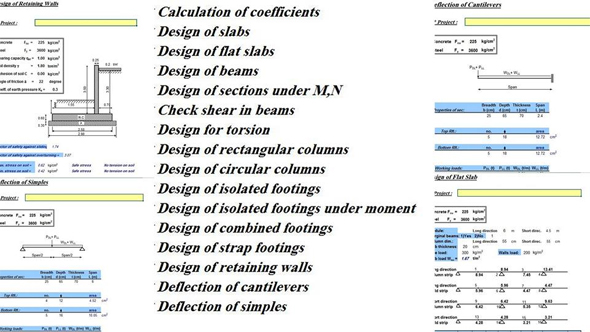Guidelines for Reinforced Concrete Design
- Concrete Cost Estimator
- Concrete Continuous Footing
- Landscape Bidding and Estimating
- Construction Cost Estimating
- Concrete and steel cost estimation
- Construction Cost Estimate Breakdown
- Construction Estimating Worksheet
- Home Construction Cost Estimate
- Estimate Pricing Sheet
- Sheet for General Contractor
- Construction Cost Estimate
- Labor Materials Cost Estimator
- Masonry Estimating Sheet
- Sheet for Building Contractor
- Construction Schedule Bar chart
- General Cost Estimator Sheet
- General Construction Estimate
- Building and Road Estimating Sheet
- Detailed expense estimates
- Door and Window Takeoff Sheet
- General Construction Cost Estimating Sheet

Usually, steel structures need only the detailed design of connections. Toward concrete structures, it is necessary to ascertain the area of longitudinal & lateral reinforcement essential in each member as well as the process to organize and connect the reinforcement efficiently to make sure that the exact structural performance is maintained.
A number of the column longitudinal reinforcement is dependent on the ACI minimum of 1% steel in the column. It ensures a well-organized design. If possible, the percentage of steel in the column should have been nearer to 4%. To reproduce this design in future, a smaller columns size is needed.
Reinforcement detailing of a slab is performed on the basis of its support conditions. Slab is supported on walls or beams or columns.
Reinforced cement concrete: As concrete is a weak material and is powerful in compression. To harden and reinforce the tensile strength of concrete, steel is applied within concrete as it is weak in tension. The steel should contain exact deformations to deliver strong bonds and interlocking of both materials. Reinforced concrete is developed when it is totally enclosed with the solidified concrete mass to produce an inherent part of the two materials.
Working stress design: This design concept is created on the basis of the elastic theory, supposing a straight line stress distribution along the depth of the concrete. The actual loads or working loads operating on the structure are calculated and members are parted in ratios based on the specific permissible stresses in concrete and steel. The permissible stresses are fractions of the crushing strength of concrete (fc’) and the yield strength (fy). Due to the variations in realism and consistency over the past several decades, the strength design method has replaced the earlier stress design method.
Link for download Excel Sheet for Reinforced Concrete Design
Limit state design: It is an advance phase of the strength design method. It specifies the state of the member in which it stops to satisfy the service requirements like loosing its capacity to resist external loads or local damage. As per limit state design, reinforced concrete members are evaluated with the following three limit states:

Ref: onlinecivilforum.com
Load bearing ability (contains safety, stability and durability):
1. Deformation (deflection, vibrations, and impact)
2. The development of cracks
3. The purpose of this analysis is to make sure that no limiting sate will be visible in the structural member throughtout its service life.
- Application of concrete calculator
- Roofing Calculator can streamline the roof estimating process
- House construction cost calculator
- Engineering column design excel spreadsheet
- Material Estimating Sheet with Excel
- Materials List and Cost Estimate Worksheet
- Concrete Slab Estimating Calculator Sheet
- Common types of foundations for buildings
- Online calculation of construction materials
- Estimating with Excel for the Small Contractor
- Concrete Beam Design Spreadsheet
- Virtual Construction Management app for construction
- Autodesk’s Project Skyscraper
- Reed Construction’s Reed Insight
- Manage your construction project documentation
- Costimator, the popular cost estimating software
- On Center Software for construction professionals
- Free Construction Estimating Software
- Plumbing Calc Pro
- Cost Estimate Worksheet
- HVAC Piping Quantity Takeoff Worksheet
- Construction Estimating Software Sheet
- Estimate Cost Templates
- Construction Punch List
- Construction cost estimating template consisting estimating basic
- Gantt Chart Template for Excel
- Download Civil Engineering Spreadsheets with Verification
- The Building Advisor Estimating and Budgeting Worksheet
- Spreadsheet for design of concrete bridge
- Construction Estimating Software Free








